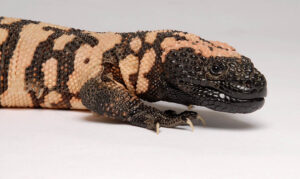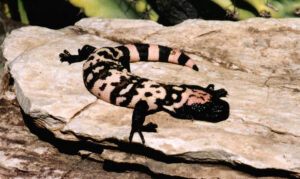About
The genus name Heloderma comes from Greek, meaning “studded skin,” and refers to these lizards’ bead-like scales that do not overlap. The Gila monster is one of only two dangerously venomous lizards in the world. Along with its relative, the Mexican beaded lizard, it uses its venomous bite for self-defense. A chemical in the saliva of Gila monsters has been found to contain a compound that helps regulate blood sugar. The substance may help Gila monsters digest meals very slowly over time. A synthetic version of this compound is currently being used in two drugs to treat diabetes.
Gila monsters’ stocky bodies are not conducive to moving very fast, which is part of the reason they are not considered very threatening to humans. Unlike many lizards, if their tails are lost, they will not regrow. In order to cope with the temperature extremes of the desert, Gila monsters spend 95 percent of their time in underground burrows. During winter, Gila monsters estivate (hibernation for reptiles) to escape the cold conditions. During the summer they spend midday underground to avoid the harsh sun.
The ancestors of Gila monsters have been traced all the way back to the Cretaceous Period. Despite some evolutionary modifications, not much has changed between those lizards and the Gila monsters surviving today. These living fossils give scientists an up-close and personal look at life in the time of the dinosaurs.
Populations are continually declining, the result of over-collection for the pet trade and habitat destruction due to urbanization and agricultural development. Concrete-lined canals are barriers to movement, as are busy highways.


Status
The most likely reason for the Gila monster’s decline in population is habit loss due to overdevelopment. There is also a small, illegal pet trade for Gila monsters, although they are protected by state laws.
Habitat
Gila monsters are found in the southwestern US and northwestern Mexico. They live in desert scrub, desert grasslands, canyons, and arroyos. The name refers to the Gila River Basin in Arizona and New Mexico, where this lizard was once common.
Diet
The primary food source of the Gila monster is eggs of birds, lizards, snakes, turtles, and tortoises. They will also occasionally dine on small mammals, birds, and lizards. Gila monsters tend to go long periods without consuming any food, so when they eat, they gorge, eating up to 35 percent of their own body weight. Excess calories are stored as fat in their tails to be used during lean times in the future.
Physical Characteristics
Body length is up to 20 inches, and weight is up to five pounds. Lifespan is 20 to 40 years.
LOCATION WITHIN THE ZOO
You’ll find this animal in the Desert LAIR. See Zoo Map.


